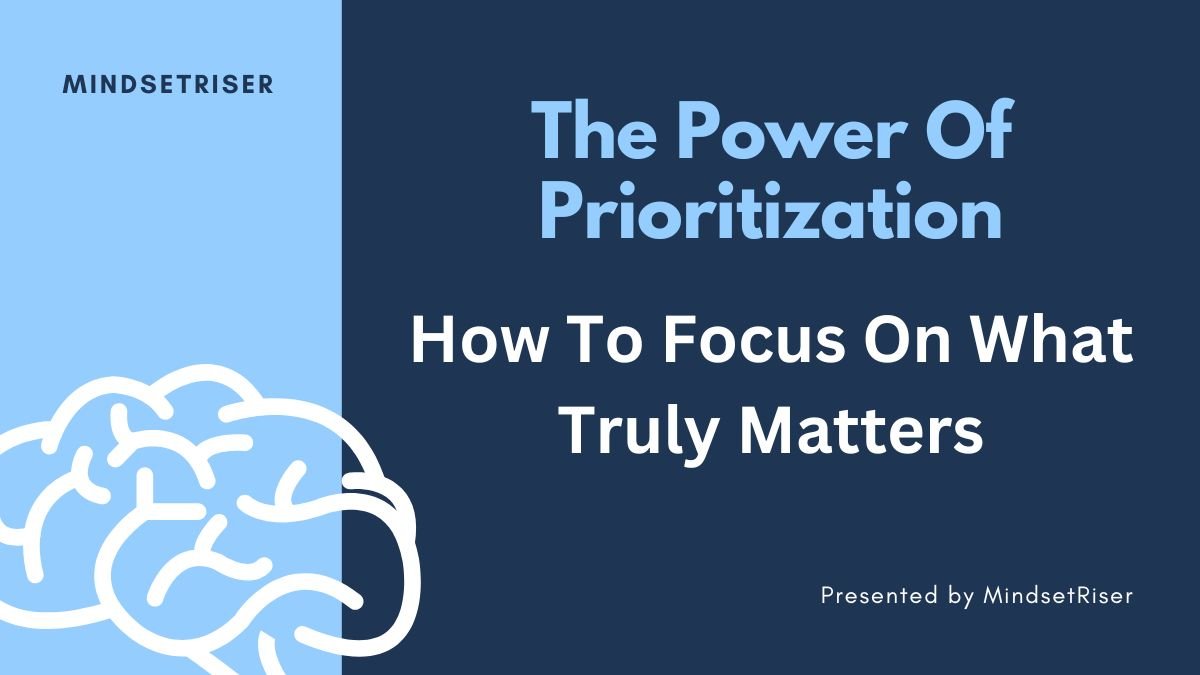The Power of Prioritization: How to Focus on What Truly Matters
In today’s fast-paced world, where distractions are abundant, the ability to prioritize effectively has become an essential skill. Whether in our personal or professional lives, we often face numerous tasks and demands, making it challenging to determine where to invest our time and energy. Prioritization helps us focus on what truly matters, align our efforts with our long-term goals, and avoid feeling overwhelmed by endless to-do lists. In this article, we will explore the power of prioritization and provide actionable strategies to help you focus on what is most important.
1. Understanding Prioritization: The Foundation of Effective Time Management
Prioritization is the process of deciding which tasks, goals, or projects deserve the most attention and resources. It involves evaluating the importance and urgency of each task and making deliberate choices about where to focus your time and energy. Effective prioritization is key to making progress in both personal and professional realms and prevents the feeling of being spread too thin.
- Key Idea: Prioritization is not just about managing time; it’s about making intentional decisions on where to invest your resources (time, energy, and focus). By prioritizing, you align your efforts with your core values and long-term goals.
- Expanded Explanation: Prioritization helps ensure that you’re directing your efforts toward the tasks that have the greatest impact. This goes beyond simply ticking off items on a to-do list—it’s about recognizing what really contributes to your personal growth, professional success, and overall well-being. By evaluating tasks based on their importance, you can make better decisions about where to focus your energy.
- Practical Application: Begin by identifying your most important goals—both short-term and long-term. Once you have a clear vision of your objectives, assess the tasks at hand based on their alignment with these goals. Rank them according to urgency and impact. The tasks that support your larger vision should be prioritized over less important, low-impact activities.
Reflection: Prioritization enables you to focus on the things that move you forward, helping you avoid wasting time on tasks that don’t contribute meaningfully to your goals.
2. The Eisenhower Matrix: A Proven Tool for Prioritizing Tasks
One of the most effective tools for prioritization is the Eisenhower Matrix, developed by former U.S. President Dwight D. Eisenhower. The matrix categorizes tasks into four quadrants based on their urgency and importance. This method helps you quickly assess what requires your immediate attention and what can be delegated, delayed, or ignored.
- Key Idea: The Eisenhower Matrix divides tasks into four categories:
- Urgent and Important: Tasks that need to be done immediately.
- Not Urgent but Important: Tasks that contribute to long-term goals and should be scheduled.
- Urgent but Not Important: Tasks that are time-sensitive but don’t align with your larger goals (delegating these is often a good choice).
- Not Urgent and Not Important: Tasks that are neither urgent nor important and can be eliminated or minimized.
- Expanded Explanation: The Eisenhower Matrix helps distinguish between tasks that demand immediate attention and those that can be postponed or delegated. By focusing on what is both urgent and important, you avoid reacting to every minor distraction and can instead prioritize the tasks that align with your long-term success.
- Practical Application: Create your own Eisenhower Matrix by listing all of your tasks and categorizing them according to urgency and importance. Focus on completing tasks in the “Urgent and Important” quadrant first. Schedule time for tasks in the “Not Urgent but Important” category, and delegate or ignore tasks in the other quadrants.
Reflection: Using the Eisenhower Matrix can help you avoid distractions and ensure that you’re always focused on tasks that align with your values and long-term objectives.
3. The 80/20 Rule (Pareto Principle): Focusing on the Vital Few
The Pareto Principle, commonly known as the 80/20 Rule, states that 80% of results often come from just 20% of efforts. This principle emphasizes the importance of focusing on the most impactful activities, which generate the greatest outcomes. Applying the 80/20 Rule to prioritization means identifying the key tasks that will yield the greatest results with the least effort.
- Key Idea: The 80/20 Rule encourages you to focus on the few activities that will have the most significant impact. By identifying and prioritizing these high-leverage tasks, you can maximize your productivity and success.
- Expanded Explanation: While it’s tempting to get caught up in a multitude of tasks, most of the value you create comes from a select few activities. This could mean focusing on the most important clients at work, the most beneficial habits for personal growth, or the most effective marketing strategies for your business. Prioritizing these high-impact tasks allows you to achieve more with less effort.
- Practical Application: Identify the 20% of your tasks that are likely to produce 80% of the results. Once you’ve identified these key activities, make them your top priority and allocate the majority of your time and energy to them. Let go of low-impact tasks or delegate them if possible.
Reflection: Applying the 80/20 Rule allows you to focus on the tasks that generate the greatest return, helping you achieve more while spending less time on less important activities.
4. Learning to Say No: The Art of Setting Boundaries
One of the most challenging aspects of prioritization is learning to say no. In a world full of opportunities, requests, and distractions, it’s easy to take on too much. However, by saying yes to everything, you risk spreading yourself too thin and diluting your efforts. Setting clear boundaries is an essential part of prioritizing what matters most.
- Key Idea: Saying no is a vital skill in effective prioritization. By learning to say no to low-value tasks and distractions, you protect your time and energy for the things that align with your goals.
- Expanded Explanation: Saying no doesn’t mean rejecting all opportunities; rather, it means being selective about what you commit to. It’s important to evaluate each opportunity or request against your current goals and priorities. If it doesn’t align with your long-term vision or if it will detract from your most important work, it’s okay to decline.
- Practical Application: Practice saying no politely but firmly when someone asks for your time or commitment. If you’re unsure about whether to accept something, take a moment to assess its impact on your goals. If it doesn’t significantly contribute to your priorities, respectfully decline. This will free up space for tasks that matter most.
Reflection: Setting boundaries and learning to say no is crucial for effective prioritization. It allows you to protect your time and focus on what truly moves you toward your goals.
5. Time Blocking: Structuring Your Day for Maximum Focus
Time blocking is a time-management technique where you divide your day into blocks of time, each dedicated to a specific task or activity. By allocating time for focused work and avoiding multitasking, time blocking helps improve productivity and ensures that you dedicate enough time to your most important tasks.
- Key Idea: Time blocking helps you dedicate specific time slots to your high-priority tasks, ensuring that you give them the attention they deserve without distractions.
- Expanded Explanation: Time blocking eliminates the tendency to jump from task to task, providing uninterrupted time to focus on what matters. It allows you to structure your day so that you can allocate focused periods for deep work, meetings, exercise, or personal time. This structured approach to your day increases efficiency and reduces decision fatigue, allowing you to maintain clarity and focus.
- Practical Application: Start by blocking out specific periods for your highest-priority tasks. For example, you could block off the first two hours of your workday for focused, uninterrupted project work, or allocate 30 minutes each morning for learning a new skill. Ensure that each block is dedicated to one task or activity only, and avoid multitasking during these blocks.
Reflection: Time blocking gives structure to your day, enabling you to focus on key tasks without distractions. By dedicating time to your most important priorities, you can make consistent progress and achieve better results.
6. Continuous Reevaluation: Adjusting Priorities as Life Changes
Priorities change over time, and it’s important to continually assess and adjust your priorities to reflect new circumstances, opportunities, and challenges. Regularly reevaluating your goals and tasks ensures that you’re always focused on what truly matters in the current moment.
- Key Idea: Reevaluating your priorities regularly helps you stay aligned with your goals and adapt to changing circumstances.
- Expanded Explanation: Life is dynamic, and what was once a priority may no longer be as relevant or important as it was before. By regularly reflecting on your goals and tasks, you ensure that you remain focused on what’s truly essential and avoid getting sidetracked by new distractions.
- Practical Application: Set aside time at regular intervals (e.g., monthly or quarterly) to review your goals and priorities. Assess whether your tasks are still aligned with your long-term vision or whether adjustments need to be made. Stay flexible and adjust your focus as necessary to ensure you’re working on what truly matters at that moment.
Reflection: Continuous reevaluation of your priorities helps you stay on track, adapt to change, and remain focused on what is most important in your life and work.
Conclusion: Mastering the Power of Prioritization
Prioritization is the key to focusing on what truly matters. By identifying your most important tasks, using tools like the Eisenhower Matrix, applying the 80/20 Rule, and learning to say no, you can manage your time and energy more effectively. With consistent reflection, time management, and adaptability, you’ll be able to prioritize what leads to meaningful progress and personal success.

